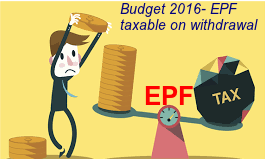Budget 2016 gave a setback to all who were concentrating on EPF for their retirement and were rejoicing that will escape tax at all stage i.e., investment, income and withdrawal. From April 2016, tax-free withdrawals shall be restricted to 40% of the corpus and mandating that the remaining amount be taxed unless it was being used to buy annuities.

After the Budget, there has been a rumour that Public Provident Fund (PPF) has also been made taxable at the time of withdrawal. But this is to clarify that only EPF has been made partially taxable on withdrawal and not the PPF. PPF is still tax free. It’s just EPF that has been moved from EEE to EET tax regime.
Before getting into details of the changes made in the budget, it is important to understand the current provision. Understand EPF taxation as per Budget 2016.
- In EPF, Employer and Employee used to contribute 12% of salary
- The amount invested was exempted under 80C
- The interest earned on this investment was exempt on accrual basis
- At the age of 58, when you get the money, was exempt as exit was exempt
This totally signifies that EPF follow EEE (Exempt, Exempt, Exempt) tax regime.
Now, in the Budget, following are the highlights:
- Investment is still tax free
- Interest earned is still tax free
- From 1 April 2016, whatever money you put in, that money (plus the interest) is taxed when you exit.
The tax is:
- 40% of that corpus is tax free.
- 60% is added to your taxable income and thus, taxed.
It is to be noted that tax applies not on the gain but the whole amount.
To make this simple, assume you have invested Rs. 10 lakhs over few years and on retirement you received Rs. 20 lakhs. Out of this 20lakhs, only 40% will be tax free and balance taxable i.e., 8lakhs (40% of 20lakh) tax free and balance 12lakh will be taxable.
Also, not to forget that limit of 80C includes many head other than EPF like school fees, housing loan principal paid back, investment in equity tax saver funds, insurance policies. So, the limit including all restricts to Rs. 1.5lakh only.
In addition, employer’s contribution of over Rs 1.5 lakh would also be ineligible for tax breaks. The new regime on withdrawals will not apply to those earning Rs 15,000 and below who have to be statutorily part of EPF.
The move was aimed at bringing parity between statutory provident fund contributions and the National Pension System (NPS), which has failed to take off due to the tax advantage enjoyed by EPF. An additional benefit of Rs 50,000 a year is available for investment in NPS. Read NPS gets exempted in Budget 2016.
The tax treatment for public provident fund, an optional savings scheme which was highly popular with investors, has been left untouched.
So, the synopsis of this amendment is that what they say is “not taxable” now, can become taxable later. So, think twice when you go for long term savings and do not take tax as granted.
___________________________________________________________________________________________________________________________________

 Toll Free:
Toll Free:  Contact Us
Contact Us

